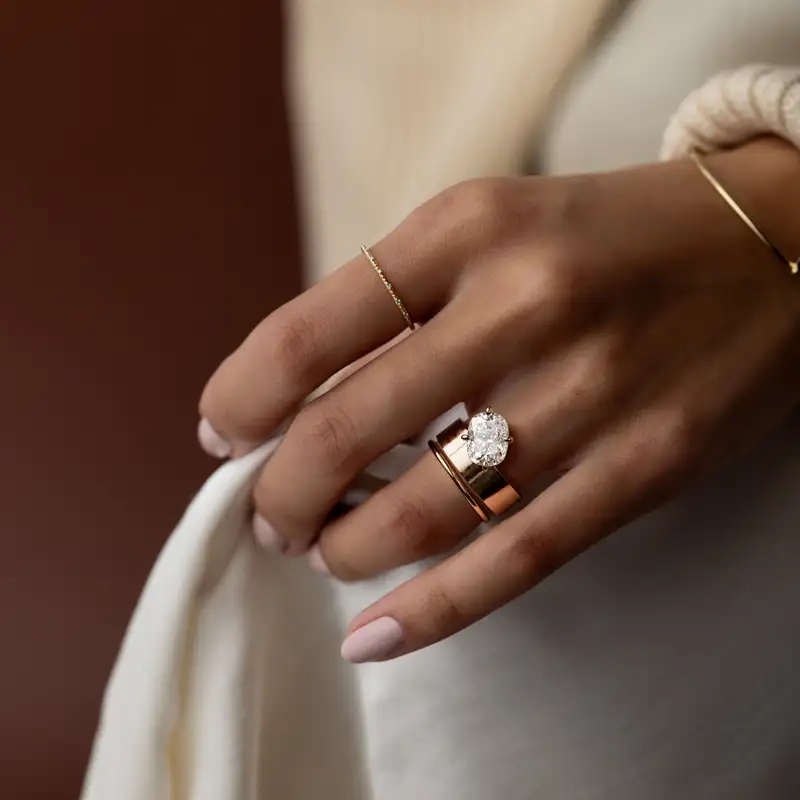 Episode 2
Episode 2
· 06:05
Imagine a diamond that carries all the romantic charm of a vintage piece, but with a silhouette that's both elegant and unexpected. Picture a shape that combines the softness and graceful length of an oval, the strong finger coverage of an emerald cut, and it's a cut that nobody else will have, it's time to introduce you to the elongated cushion cut diamond, a shape that brings together the best of all worlds for a truly unique statement. I'm Melanie Casey, fine jewelry designer and founder of Melanie Casey Jewelry. Today, we're exploring what makes the elongated cushion cut so special and why it's become a favorite among those who want a ring that's anything but ordinary. Let's start with what the elongated cushion cut actually is and where it comes from.
Melanie Casey:The cushion cut itself is one of the oldest diamond shapes loved for its soft rounded corners and pillowy outline. In the early nineteen hundreds, diamonds were often hand cut by artisans into what was known as the old mine cut. Today, when most people think of a cushion cut, they picture a square, but the elongated cushion stretches that classic style into a more rectangular form. For me as a designer, that longer ratio is where the inspiration begins. It's the blend of old world character and modern faceting that makes the elongated cushion cut so exciting.
Melanie Casey:So why would you choose an elongated cushion cut over more popular diamond shapes? From my perspective, this unexpected cut makes for a completely unique engagement ring, and that's one of the reasons I love it so much. Longer shaped diamonds are incredibly finger flattering. The elongated outline naturally lengthens the look of the hand, creating a graceful line that other shapes can't match. This stone is also known for its brilliance.
Melanie Casey:An elongated cushion has precise faceting that shines just as bright as the more well known cuts like round and princess. It carries vintage charm while still feeling undeniably modern. Because of its proportions, this cut often looks larger on the hand than a square cushion of the same weight. That's a little designer secret for maximizing impact without increasing carat size. The elongated cushion works beautifully in almost any style from a clean solitaire to a bold bezel or a delicate cluster.
Melanie Casey:It's a favorite for those who want something unique and refined, not something they'll see in every jewelry store. If you're considering an elongated cushion, here's exactly how I evaluate them when sourcing stones. Choosing the right diamond is just as important as the right setting. First, you should consider the cut quality. This considers things like symmetry and precision in the facets.
Melanie Casey:Even the slightest variation in symmetry changes how the light reflects out of the diamond. I recommend very good or excellent cuts because precision is what brings the sparkle alive. Next, you should consider the color grade. High color is key. With their larger surface area, elongated cushions show color a bit more than some shapes.
Melanie Casey:For natural diamonds, I recommend g or higher. For lab grown, f or higher will keep the stone looking crisp and bright. Clarity is another factor you will need to decide, but luckily, this one is easy. Cushion cuts are forgiving, so a v s two in natural or a v s one in lab grown will usually look eye clean without overspending on flawless grades. Finally, consider the ratio.
Melanie Casey:This is not one of the four c's, and it's the most important consideration for this cut. This detail transforms the entire look. For an elegant elongated style, I suggest a ratio of at least 1.1. Personally, I love 1.2 or longer. Anything too close to square loses the finger lengthening effect that makes this cut so distinctive.
Melanie Casey:Longer stones feel intentional and designer. They're harder to source, but that's what makes them special. Now let me share a few examples from my collection that highlight the versatility of this cut. In our solitaire style threaded ring, the elongated cushion sits on a slim minimal band with a triple prong basket. The clean setting draws the eye directly to the stone, creating a classic, timeless look.
Melanie Casey:For a more modern solitaire, the formation ring pairs the elongated cushion with a sleek bezel. It enhances the silhouette, adds structure, and transforms a traditional solitaire into something strikingly contemporary. And for sparkle lovers, our signature snowdrift ring surrounds the elongated cushion with delicate clusters of side stones. The effect is romantic, ethereal, and completely unique. Vintage inspiration made modern.
Melanie Casey:Each of these designs shows the adaptability of the elongated cushion. Whether understated or detailed, this cut elevates an engagement ring with a presence that feels refined, timeless, and unmistakably distinctive. So there you have it, the elongated cushion cut diamond, a shape that, blends the romance of antique hand cut stones with the precision of modern faceting. It flatters the hand, delivers sparkle, and offers a presence you won't mistake for ordinary. As a designer, I love this cut because it refuses to blend into the crowd.
Melanie Casey:It's elegant, versatile, and full of character. The perfect choice if you want an engagement ring that is completely unique yet understated. If you'd like to see some of my favorite elongated cushion cut designs, head over to melaniecasey.com and explore the collection. You'll find solitaire's, bezel's, clusters, and more. Each one designed to bring out the best in this beautiful shape.
Melanie Casey:Thanks for listening to the engagement ring podcast. I'm Melanie Casey, and I'll see you in the next episode.
Listen to The Engagement Ring Podcast by Melanie Casey Jewelry using one of many popular podcasting apps or directories.